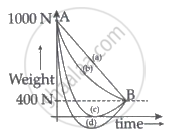Advertisements
Advertisements
Question
The acceleration of the moon just before it strikes the earth in the previous question is
Options
10 m s−2
0⋅0027 m s−2
6⋅4 m s−2
5⋅0 m s−2
Solution
6⋅4 m s−2
According to the previous question, we have :
Radius of the moon, \[R_m = \frac{R_e}{4} = \frac{6400000}{4} = 1600000 m\]
So, when the Moon is just about to hit the surface of the Earth, its centre of mass is at a distance of (Re + Rm) from the centre of the Earth.
Acceleration of the Moon just before hitting the surface of the earth is given by
\[g' = \frac{GM}{( R_e + R_m )^2} = \frac{GM}{{R_e}^2 (1 + \frac{R_m}{R_e} )^2}\]
\[ \Rightarrow g' = \frac{g}{(1 + \frac{R_m}{R_e} )^2} = \frac{10}{(1 + \frac{1}{4} )^2} = \frac{10 \times 16}{25}\]
\[ \Rightarrow g' = 6 . 4 m/ s^2\]
APPEARS IN
RELATED QUESTIONS
If heavier bodies are attracted more strongly by the earth, why don't they fall faster than the lighter bodies?
The earth revolves round the sun because the sun attracts the earth. The sun also attracts the moon and this force is about twice as large as the attraction of the earth on the moon. Why does the moon not revolve round the sun? Or does it?
Take the effect of bulging of earth and its rotation in account. Consider the following statements :
(A) There are points outside the earth where the value of g is equal to its value at the equator.
(B) There are points outside the earth where the value of g is equal to its value at the poles.
Find the height over the Earth's surface at which the weight of a body becomes half of its value at the surface.
A mass of 6 × 1024 kg (equal to the mass of the earth) is to be compressed in a sphere in such a way that the escape velocity from its surface is 3 × 108 m s−1. What should be the radius of the sphere?
If the acceleration due to gravity becomes 4 times its original value, then escape speed ____________.
Explain the variation of g with altitude.
Explain the variation of g with depth from the Earth’s surface.
If both the mass and the radius of the earth decrease by 1%, then the value of acceleration due to gravity will
The earth is an approximate sphere. If the interior contained matter which is not of the same density everywhere, then on the surface of the earth, the acceleration due to gravity ______.
Which of the following options are correct?
- Acceleration due to gravity decreases with increasing altitude.
- Acceleration due to gravity increases with increasing depth (assume the earth to be a sphere of uniform density).
- Acceleration due to gravity increases with increasing latitude.
- Acceleration due to gravity is independent of the mass of the earth.
A person whose mass is 100 kg travels from Earth to Mars in a spaceship. Neglect all other objects in the sky and take acceleration due to gravity on the surface of the Earth and Mars as 10 m/s2 and 4 m/s2 respectively. Identify from the below figures, the curve that fits best for the weight of the passenger as a function of time.

If R is the radius of the earth and g is the acceleration due to gravity on the earth's surface, the mean density of the earth is ______.
A ball is immersed in water kept in container and released. At the same time container is accelerated in horizontal direction with acceleration, `sqrt44` m/s2. Acceleration of ball w.r.t. container is ______ m/s2 (specific gravity of ball = 12/17, g = 10 m/s2)
The percentage decrease in the weight of a rocket, when taken to a height of 32 km above the surface of the earth will, be ______.
(Radius of earth = 6400 km)
